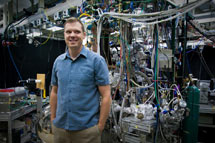
Handy Links
SLAC News Center
SLAC Today
- Subscribe
- Archives: Feb 2006-May 20, 2011
- Archives: May 23, 2011 and later
- Submit Feedback or Story Ideas
- About SLAC Today
SLAC News
Lab News
- Interactions
- Lightsources.org
- ILC NewsLine
- Int'l Science Grid This Week
- Fermilab Today
- Berkeley Lab News
- @brookhaven TODAY
- DOE Pulse
- CERN Courier
- DESY inForm
- US / LHC
SLAC Links
- Emergency
- Safety
- Policy Repository
- Site Entry Form

- Site Maps
- M & O Review
- Computing Status & Calendar
- SLAC Colloquium
- SLACspeak
- SLACspace
- SLAC Logo
- Café Menu
- Flea Market
- Web E-mail
- Marguerite Shuttle
- Discount Commuter Passes
-
Award Reporting Form
- SPIRES
- SciDoc
- Activity Groups
- Library
Stanford
Around the Bay
People: Nick Melosh is More than a Materials Guy
Jumping electrons gave Nick Melosh the unexpected idea, as initial results often do.
"Oh, that's interesting, so where do you go next?" said Melosh, a researcher in the Stanford Institute for Material and Energy Sciences at SLAC, the Geballe Laboratory of Advanced Materials, and the Stanford Department of Materials Science and Engineering.
After showing that metals coated with carbon molecules could efficiently emit electrons from their surfaces, Melosh and coworkers thought of applying the results to electron microscopy and flat-panel display technologies. Then they realized this property could be applied to semiconductors for capturing solar energy. "You get to a place you never would have envisioned when you started," he said. And the work has panned out from there.
Last December, the 2010 Mohr Davidow Ventures Innovator Award gave Melosh added funds to develop the new idea for solar energy capture. The method would use the strengths of two existing solar energy technologies—photovoltaic cells and thermal conversion devices— in a novel way.
"It's a good example of how fundamental science in seemingly unrelated materials could give you new directions to go," Melosh said.
It was his interest in fundamentals that drew Melosh to major in chemistry at Harvey Mudd College in Claremont, California. Growing up in a scientific family, he always assumed he would become a researcher. He said he was attracted to chemistry because he enjoyed seeing the connection between people's tactile, real-world experiences and the realm of atoms.
"Why are metals shiny? Why do they have the ability to be bent?" Melosh said. "If you understand how things are arranged and their behavior at the atomic level then you can start to extrapolate to larger scale properties… How nature works is really incredible when you get into the details."
But his ultimate focus would be to apply what he learned. He shifted direction from chemistry into materials science during his doctoral work with Brad Chmelka and Galen Stucky at UC Santa Barbara. Next, he worked with nanotechnology as a postdoc in Jim Heath's lab at UC Los Angeles and Caltech.
His graduate and postdoctoral work influenced the broad questions Melosh and his lab have studied since he came to Stanford in 2003. His lab now works on problems in molecular electronics and in the interaction between nanotechnology and biology.
But perhaps his mountain biking hobby, resulting in a year-round tan, helped inspire the recent intellectual leap toward solar energy.
Solar energy currently forms a small fraction of the total energy usage in the United States, partly due to the low efficiency with which it can be captured. One common technology, photovoltaic cells, converts sunlight into energy quite efficiently. But the cells capture only particular wavelengths of light and miss the rest.
Another technology, solar thermal conversion, uses all incoming light to generate electricity indirectly, for instance by heating steam to power a turbine. But much of the heat is lost, making solar thermal conversion no more efficient than most photovoltaic cells.
In theory, it would be great to combine the two technologies: Photovoltaics could capture some energy efficiently and thermal conversion could inefficiently use the rest. But in practice, photovoltaics wilt at the high temperatures where the thermal process works best.
Watching materials spit out electrons clued Melosh and his collaborators in to a new possibility. In semiconductors such as silicon, certain wavelengths of sunlight can bump electrons up an energy level. From there, it's just a small energy step for the electron to dive off the substance entirely, creating an electric current that can withstand high temperatures. Heat from the sun would supply that extra nudge. What's more, because the process works best at high temperatures, it could be combined with solar thermal conversion to use the leftover heat.
Every day, the team tests different materials for the process, affectionately known as PETE—Photon Enhanced Thermionic Emission.
"This is very straight-forward physics, there's nothing really outlandish here," Melosh said. "But anything involving a new physical process is somewhat risky. The question is, is it going to be 1 percent efficient, 10 percent efficient, or 50 percent efficient."
"It could just be days before we know whether a particular material really shows this effect," Melosh said.
But it's such non-standard ideas that could bring down the cost of renewable energy considerably, he said. "We're kind of on the fundamental level of things but you at least see a trajectory of where these things will go."
—Olga Kuchment
SLAC Today, January 27, 2010
